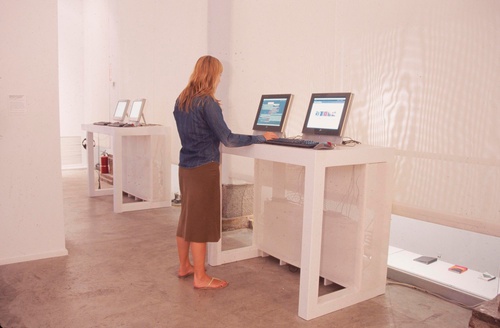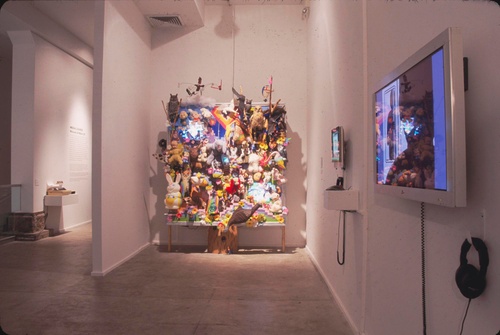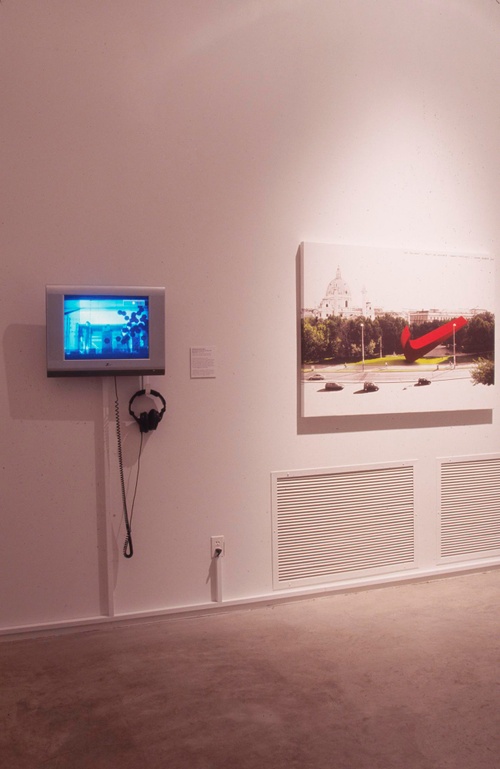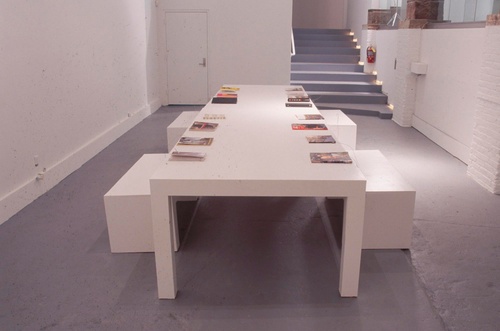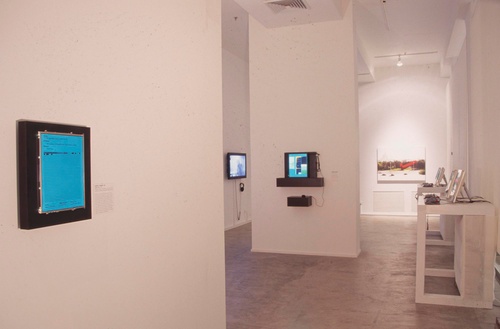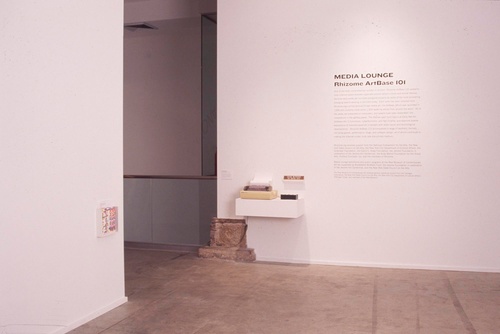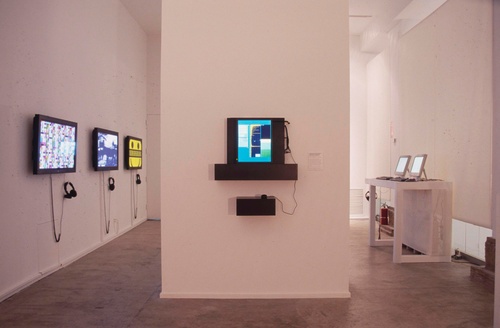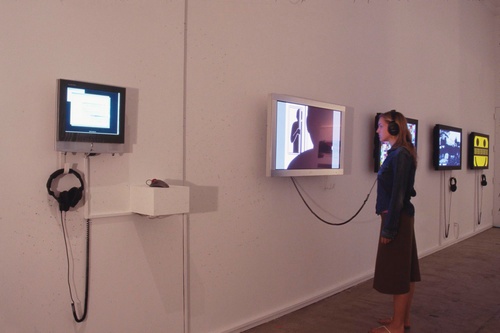Rhizome ArtBase 101
Rhizome ArtBase 101
RHIZOME ARTBASE 101 surveys salient themes in Internet-based art-making, a practice that has flourished in the last ten years. The exhibition presents forty selections from Rhizome.org’s online archive of new media art, the ArtBase, which was launched in 1999 and currently holds some 1,500 works by artists from around the world. Featured works are grouped by ten unifying themes and include seminal pieces by early practitioners as well as projects by some of the most pioneering emerging talents working in the field today.
Encompassing software, games, moving image and websites installed on computers or elaborated in installations, Rhizome ArtBase 101 presents the Internet as a strapping medium that rivals other art forms in its ability to buttress varied critical and formal explorations. A number of projects respond to E-COMMERCE by disturbing online consumption, often through satire and emulation. Portland-based artist damali ayo riffs on the commodification of identity in rent-a-negro.com (2003), a service that offers the companionship of an African American person for a price but free of the commitment of “challenging your ownwhite privilege.” RTMark, a brokerage firm of international artists, supports initiatives that sabotage corporate products and protocol through their headquarters, rtmark.com. British duo Thomson and Craighead provide a counterpoint to such direct engagements of capitalist enterprise in dot-store (2002), a line of goods that investigates the historical overlap between individual expression and commercial communication systems.
With cutting edge graphic interfaces and dependence on a player, GAMES provide rich terrain for artistic intervention. Works, like Sheik Attack (1999) by Israeli-born artist Eddo Stern, recontextualize game narratives to reveal the social and political agendas embedded in their structure. Modification, whereby artists hack into virtual worlds to alter their landscape or action, is a form of game art that echoes the equally interventionist traditions of graffiti and tagging. In Adam Killer (2000), Los Angeles-based artist Brody Condon restricts the first person capability of the player to killing and destruction only.
Although historicizing an emerging art practice is never simple, there are some landmark works that undoubtedly established a critical and formal context for Internet art practices as we see them today. EARLY NET.ART, represented in the ArtBase chiefly by European artists active in the mid to late 1990s, include such classic projects such as _readme (1998) by Heath Bunting and Desktop Is (1997) by Russian artist Alexei Shulgin. The latter project effectively reframed the computer desktop as a formal platform by aggregating artists’ varied experiments with the basic computer interface. By exploring these very different “desktops,” we can see how Internet artists were able to work online in an individualistic mode while at the same time operating in the context of an artistic community that was launching new projects using the Web and e-mail.
The Internet has provided a platform for exploration, action, and protest by artists who create works under the rubric of CYBERFEMINISM. American artist Prema Murthy plays with the “goddess/whore” paradigm in Bindigirl (1999). In this work, which parodies South Asian cyberporn sites, a character called Bindi speaks of the failure of new technologies to liberate her from constricting religious and gender identities. In another classic and pioneering work, Brandon (1998), whose source material is the true story of Tina Brandon, nomadic artist Shu Lea Cheang represents the paranoia and distrust around transgendered bodies by deploying graphic imagery and details across multiple screens and in diverse international locations…. SOFTWARE ART takes generative processes and code as its main source material, examining these as cultural forms rather than merely neutral sets of command sequences. Many software art projects interrogate the mechanisms of control that underlie software by destabilizing rote experiences of computing. Through its open source, cross-platform design the early program The Web Stalker (1997) by British collective I/O/D prompted a consideration of how commercial software limits options and experimentation. Conversely, theBot (2000) by American artist Amy Alexander downplays functionality in order to visualize certain operations that software enables, such as searching and rendering images. DATA VISUALIZATION AND DATABASES manifest relationships between informational entities that might otherwise remain invisible or even unthinkable. Created using RSG’s network surveillance program Carnivore (2001-2003), Los Angeles-based programmer Mark Daggett’s Carnivore Is Sorry (2001) tracks users as they navigate the Web, then compresses the sites they visited into an abstract, data-dense jpeg and e-mails it to them. Databases have been employed to reorganize existing arrangements into new narratives or situations. One Year Performance Video (akasamhsiehupdate) (2004) sources prerecorded clips of Brooklyn-based artists M. River and T. Whid of MTAA into a streaming video diptych that simulates a fictional narrative of the artists living in adjacent, identical white cells for the duration of a year.
Artists interested in ONLINE CELEBRITY enlist personal platforms like blogs and homepages, and the gossipy, reflexive nature of the Internet, to transform personal behavior into public spectacle. On Marisa Olson’s American Idol Audition Training Blog (2004), the San Francisco-based artist exhaustively documents the pitfalls and nervous anticipation involved in her attempt to become the next American Idol. In Diary of a Star (2004), Los Angeles-based artist Eduardo Navas re-contextualizes selections from The Andy Warhol Diaries (edited by Pat Hackett) to connect this earlier artist’s legendary self-awareness to the attitudes of today’s online personas. Embedded within layers of metadata and links, each diary entry’s potential to spread across net appears infinite. Aided by the proliferation of wireless technologies, new media artists encode, decode and scramble PUBLIC SPACES through electronic networks. In the audio storytelling project murmur by Canadian artists Shawn Micallef, James Roussel, and Gabe Sawhney, pedestrians can dial into a central database to share or hear location-specific stories about the area they are calling from. For Nike Ground (2003), the international team of artists known as 0100101110101101.org employed Internet-based marketing strategies (Web sites, e-releases) to fool the city of Vienna into believing that their beloved Karlplatz had been acquired by Nike and was to be supplanted by a monumental Swoosh.
NET CINEMA puts film and video in dialogue with digital aesthetics such as hypertext, databases, and algorithms. SUPER SMILE (2005) by Korean-based duo YOUNG-HAE CHANG HEAVY INDUSTRIES, evokes multiple film genres - romance, action, noir through the rhythm and pace of its experimental, text-based narrative. The flourishing of commercial media programs such as Flash in recent years has seeded new possibilities for moving image online. Still, some artists are more interested in a program’s vulnerabilities than in its options. For his series Data Diaries (2003), New York artist Cory Arcangel tricked QuickTime into reading his daily desktop debris (old e-mails, jpegs, and Word documents) as media files, a maneuver that produced dozens of mesmerizing and abstract streaming videos.
Projects described as DIRT STYLE appropriate graphic detritus from the Web in gestures that both celebrate and satirize digital pop culture. In extreme animalz: the movie: part 1 (2005) by U.S.-based collective Paper Rad and Pittsburgh-based artist Matt Barton gif files of animals, sourced through Google’s Image Search, are woven into a digital tapestry that is mirrored by a surrounding cluster of mechanized stuffed animals. Dirt Style works often express nostalgia through repurposing analog technology. In Dot Matrix Synth (2003), American artist Paul Slocum reprogrammed a dot matrix printer so that it plays electronic notes in accordance with different printing frequencies.

